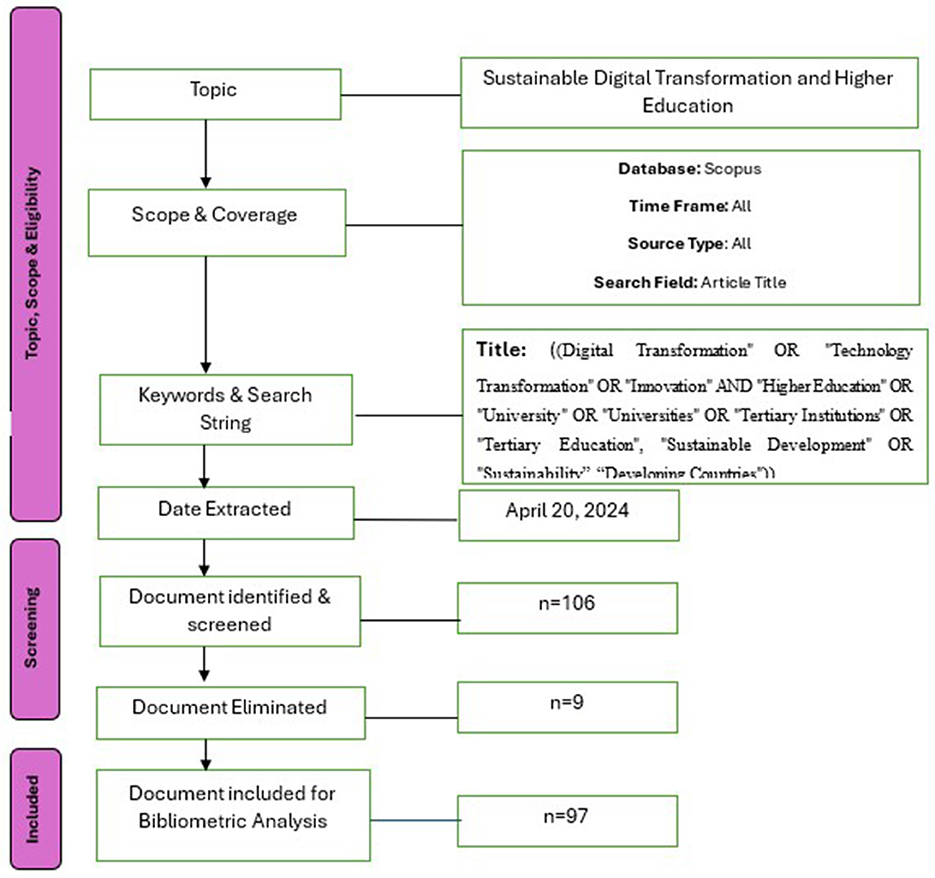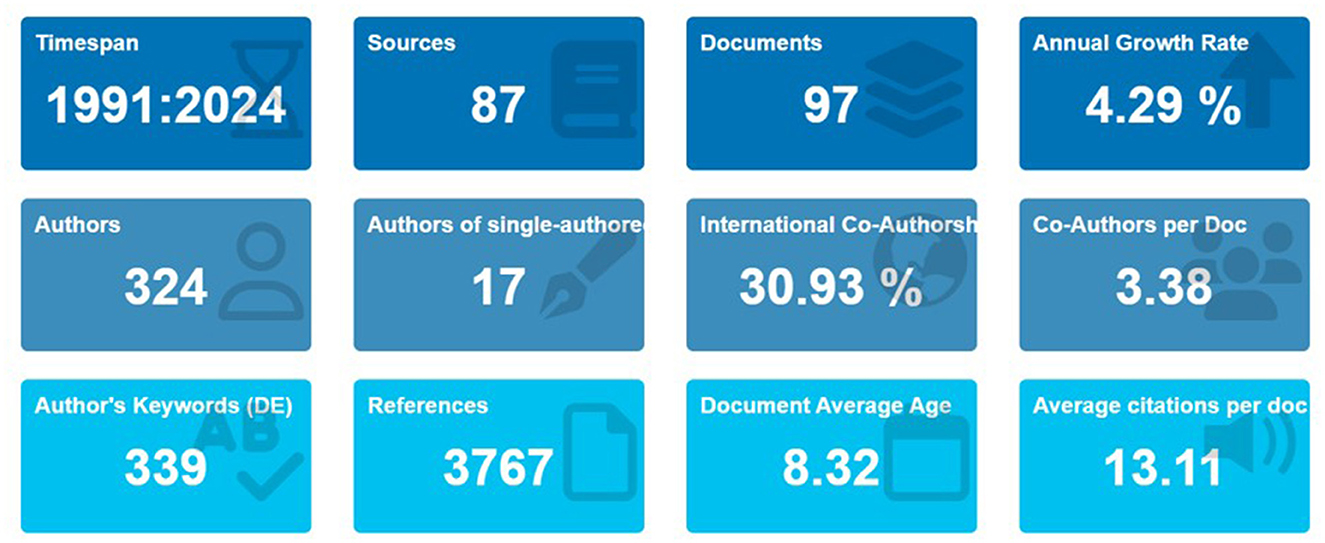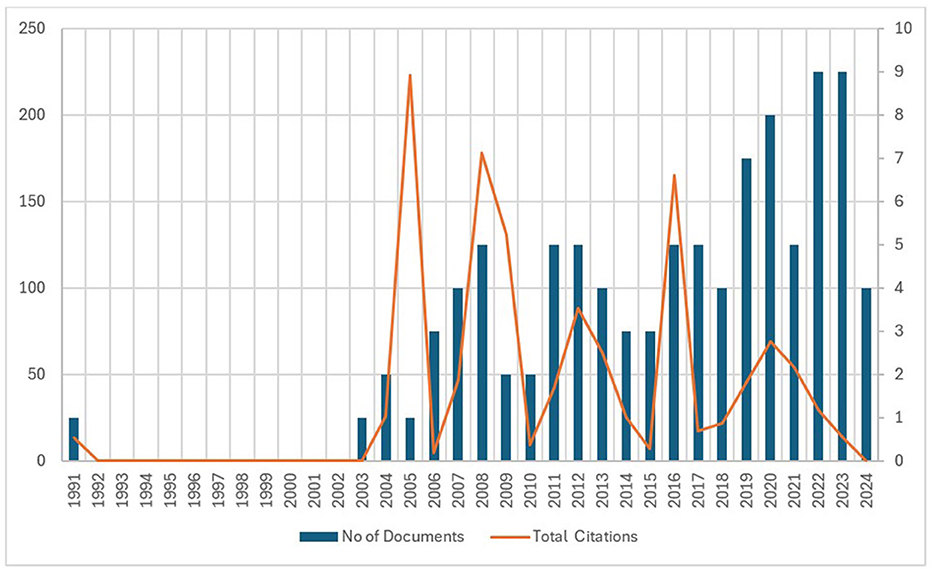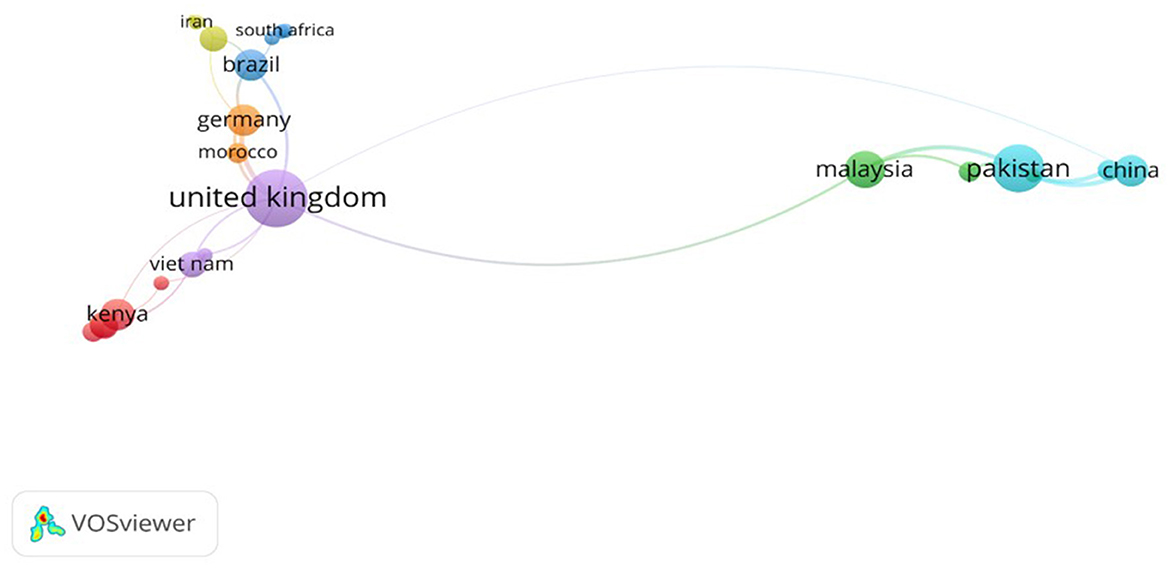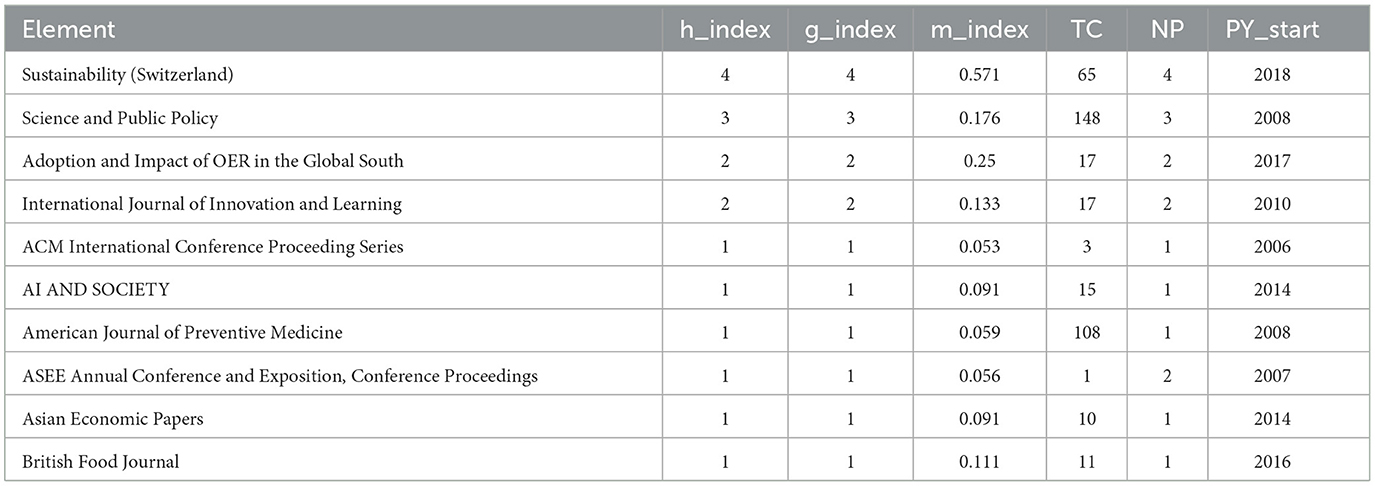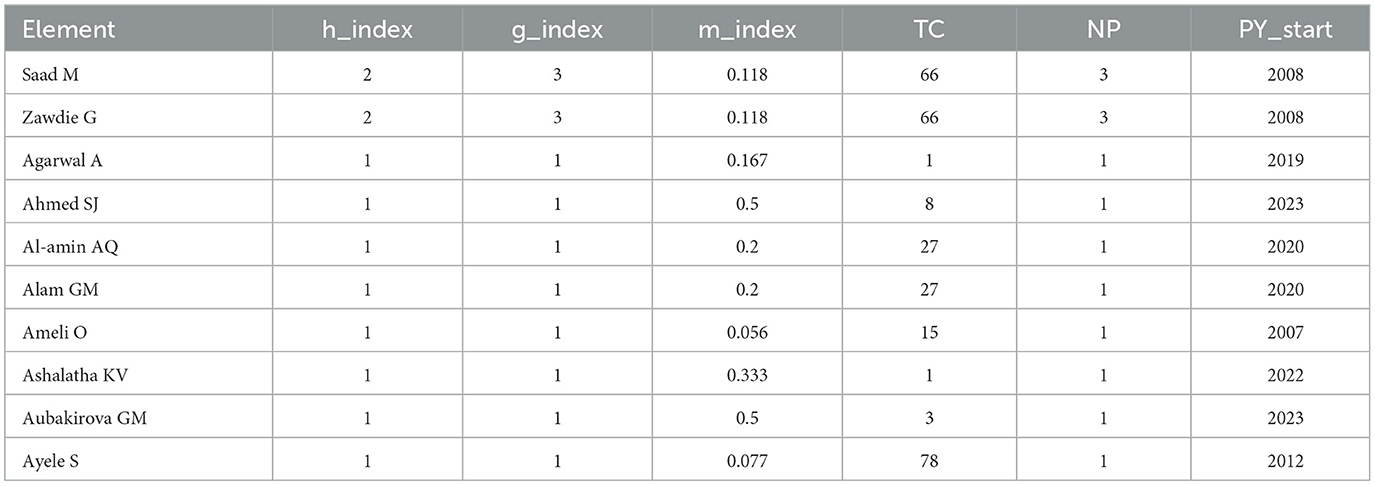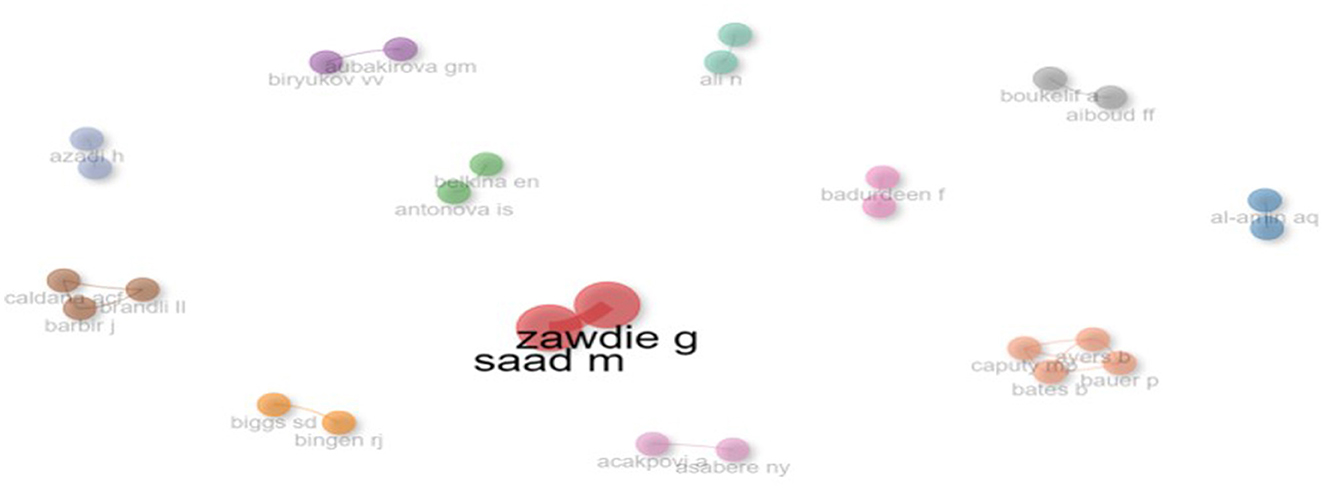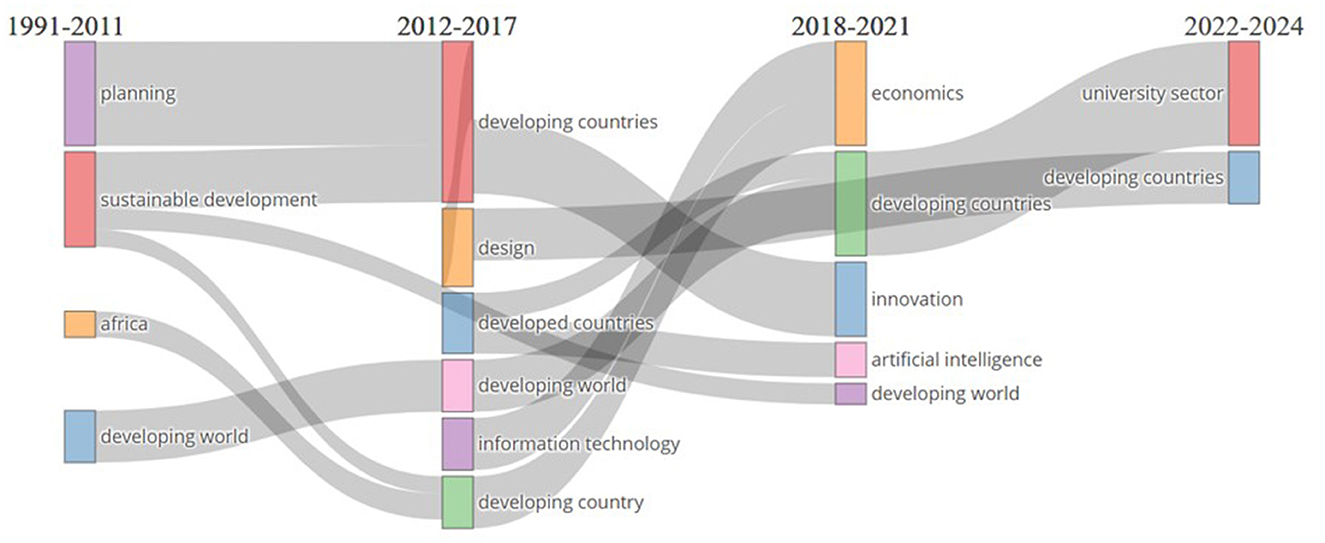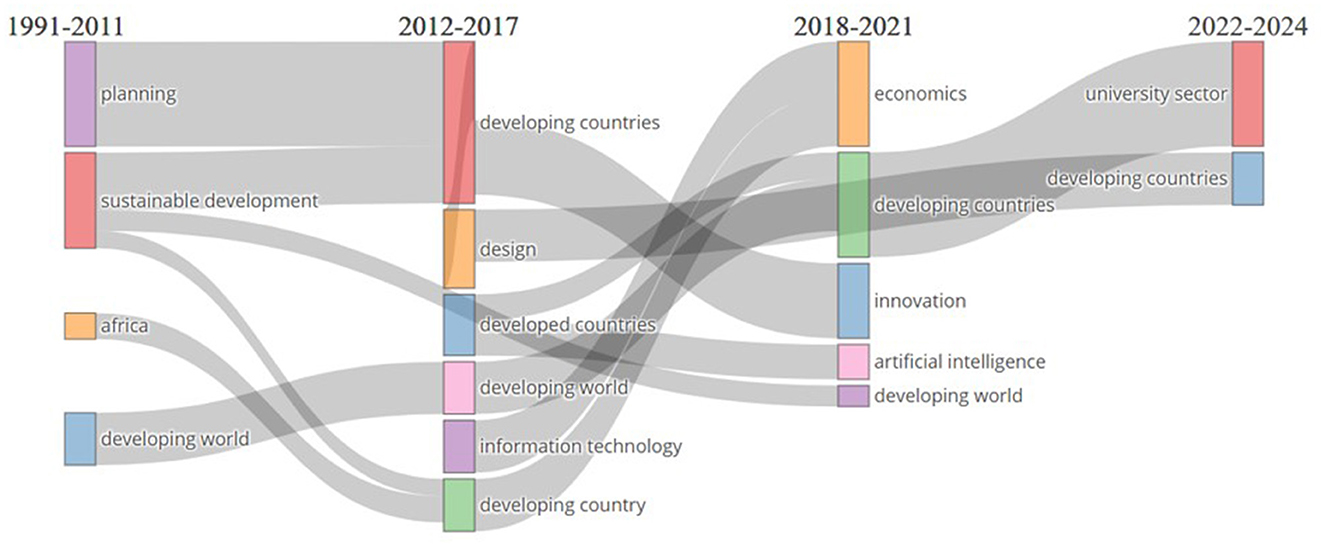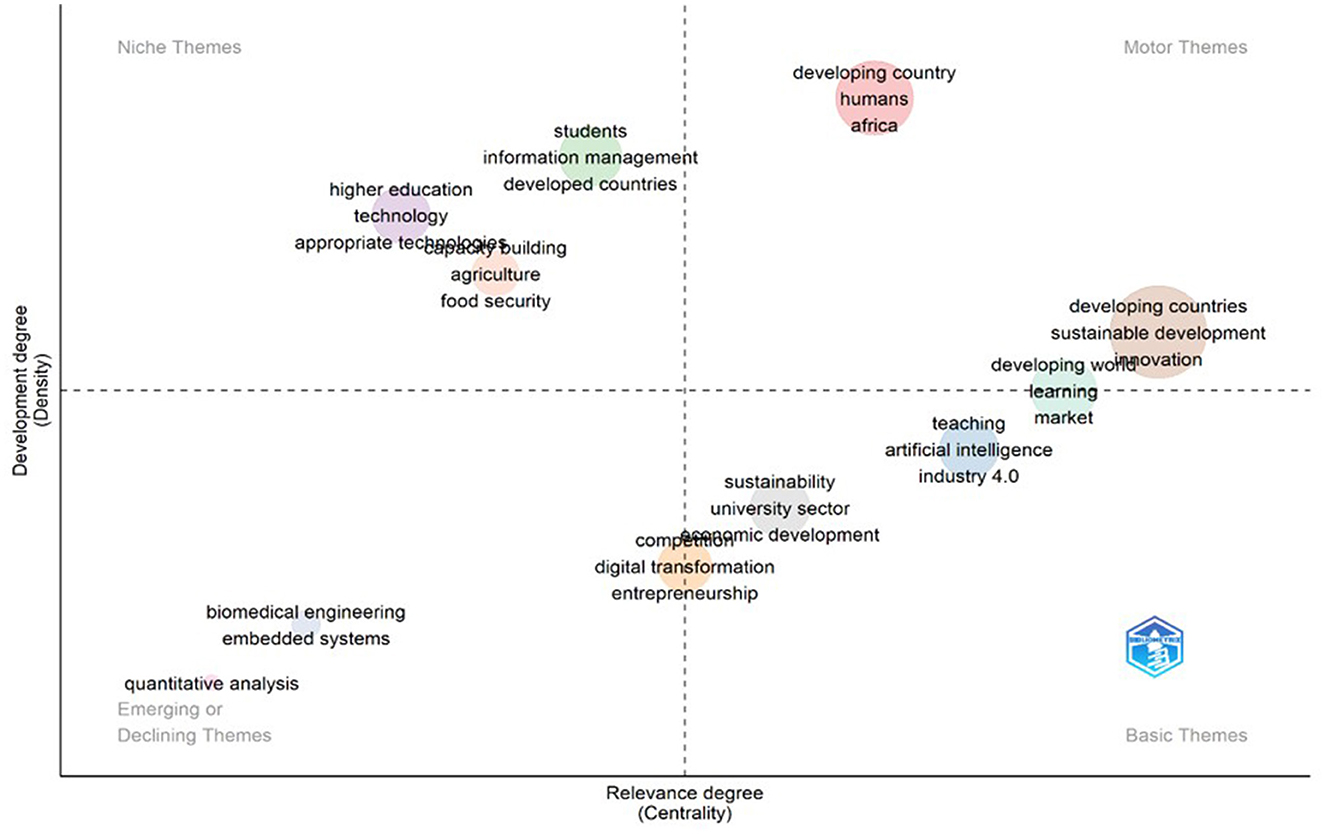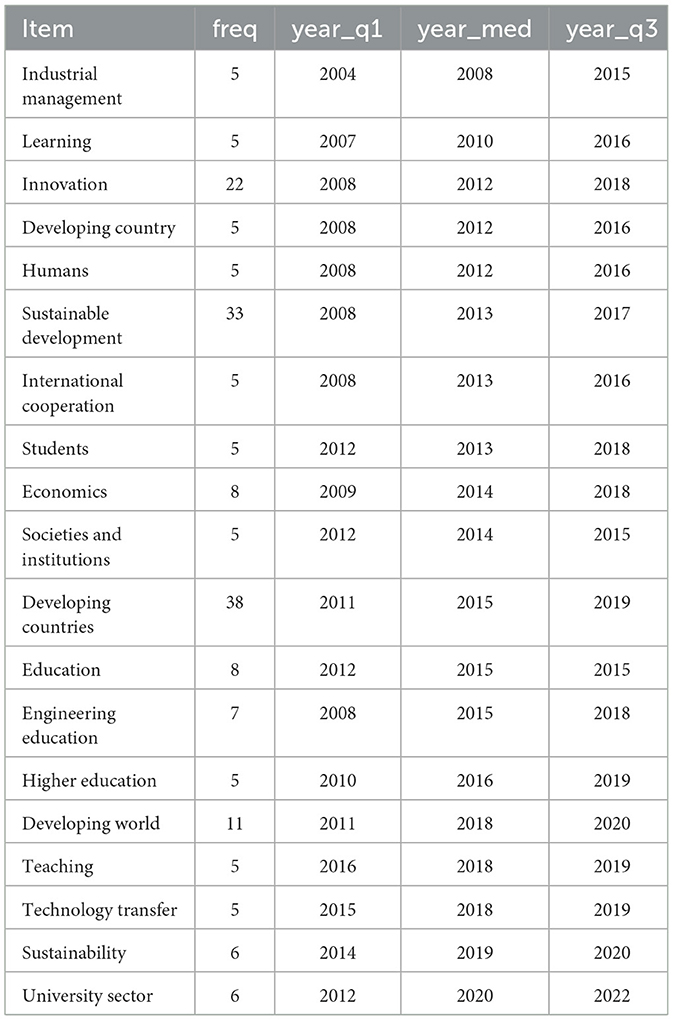- 1Faculty of Education, SIMAD University, Mogadishu, Somalia
- 2Faculty of Computing, SIMAD University, Mogadishu, Somalia
The integration of digital technologies in higher education has revolutionized educational experiences, processes, and pedagogical methods, particularly in developing countries. Additionally, sustainability in education has become a critical focus, aligning with global efforts to promote sustainable development. This study conducts a comprehensive bibliometric analysis to investigate research trends and patterns in sustainable digital transformation (SDT) within higher education in the context of developing countries from 1991 to 2024. Employing the SCOPUS database, the analysis reveals a significant increase in publications on this topic, highlighting a growing scholarly interest. Key themes identified include digital transformation, innovation, sustainability, and technology-enhanced learning environments. Influential sources and journals contributing to this field are identified, with the Journal of Educational Technology & Society being the most cited. Collaboration networks among researchers are analyzed, showcasing the interconnectedness and interdisciplinary nature of this research area. Thematic evolution mapping indicates a shift from addressing challenges and barriers to exploring opportunities and benefits of digital transformation. The findings underscore the need for tailored approaches to address the unique socio-economic and cultural challenges faced by developing countries. This study fills a gap in the literature by providing a comprehensive overview of how SDT is being explored and implemented in higher education institutions in developing countries, offering insights into future research directions and practical implications for sustainable development in this sector.
1 Introduction
The exponential integration of digital technologies in higher education has led to a significant transformation in educational experiences, processes, and teaching and learning methods (Buzzetto-Hollywood et al., 2018; Saykili, 2019; Truong and Diep, 2023). Consequently, there is a growing body of literature on Sustainable Digital Transformation (SDT) in higher education, particularly in developing countries. Research on SDT in higher education in developing countries emphasizes the importance of practices that meet the needs of current students and faculty while ensuring access to quality education for future generations (Trevisan et al., 2024; Sparks and Katz, 2016). This includes efforts to promote environmental sustainability, such as reducing energy consumption on campuses, as well as social sustainability, aimed at creating an inclusive and equitable learning environment. Digital transformation involves integrating digital technologies into all aspects of university operations., including the utilization of online learning platforms, developing digital educational resources, and adopting innovative technologies for communication and collaboration (Akour and Alenezi, 2022; Ashmel et al., 2022). It explores how universities in developing nations can utilize technology to achieve academic objectives while minimizing environmental impact and promoting social responsibility. The focus on SDT in developing countries arises from the need to address unique challenges, including limited resources, inadequate infrastructure, and the digital divide in higher education (Goncalves and Oliveira, 2018; Yang et al., 2022).
Studies have examined the role of emerging technologies like artificial intelligence, blockchain, and virtual reality in advancing sustainability goals in higher education institutions in developing nations (Bucea-Manea-Ţoniş et al., 2021; Chaka, 2023). Scholars have also analyzed the impact of SDT on various stakeholders, including students, faculty, administrators, and local communities (Bucea-Manea-Ţoniş et al., 2021; Trenerry et al., 2021). Research suggests that SDT initiatives can yield positive outcomes, such as increased student engagement, enhanced institutional reputation, and greater social responsibility (Alojail and Khan, 2023; Brunetti et al., 2020). Bibliometric studies have made noteworthy contributions to our understanding of research trends in technology, education, sustainability, and organizational studies in developing countries (Hallinger and Chatpinyakoop, 2019; Grosseck et al., 2019). Bibliometric analyses have proven effective in uncovering trends, identifying major research themes, and highlighting emerging areas of interest in developing countries (Razali et al., 2024). Multiple studies are necessary to map the landscape of sustainable digital transformation in higher education within developing countries comprehensively. Such studies would shed light on the evolution of research topics, publication patterns, and the extent of interdisciplinary collaborations (Bustamante-Mora et al., 2023; Braßler and Schultze, 2021).
One noteworthy trend that may be observed is the increasing focus on constructing sustainable digital infrastructure and technology-enhanced learning environments suitable for developing countries (Valdés et al., 2021; D'Ambra et al., 2022). Researchers can explore strategies to reduce energy consumption, promote digital equity, and incorporate sustainability principles into curriculum design tailored to the specific needs of developing countries. To our understanding, no studies have delved into sustainable digital transformation in developing countries higher education. March 2024, an extensive search was conducted in the SCOPUS database using key search terms such as “sustainability,” “digital transformation,” and “higher education” to investigate the extent and nature of research exclusive to developing countries. This study aims to identify the scope and depth of research on sustainable digital transformation in higher education within developing countries. Previous bibliometric studies have separately examined the topics of digital transformation and sustainability. However, there is a clear gap in the literature regarding the intersection of these two areas in higher education institutions in developing countries. This study seeks to address this gap by conducting an analysis of trends, identifying key contributors, and evaluating the impact of research in this field. By filling this research deficit, the study will provide a more comprehensive understanding of how sustainable digital transformation is being explored and implemented in higher education institutions in developing countries.
2 Methodology
Bibliometric studies are indispensable for evaluating and comprehending research publications' significance, impact, and trends within specific domains, such as sustainable digital transformation in higher education. These studies comprehensively understand the current research landscape using quantitative and qualitative techniques to analyze journals, articles, and associated citations over time (Gou et al., 2023). Such analyses aid researchers in identifying research topics, refining their focus, and predicting future trends (Kozhakhmet et al., 2023).
Bibliometric analysis allows for estimating publication numbers and trends within specific fields, facilitating a quantitative literature review by establishing connections between relevant keywords (Donthu et al., 2021; Linnenluecke et al., 2020). This standardized method evaluates written communication among authors (Skute et al., 2019), quantifies research trends and characteristics (Alqudah et al., 2023), and scrutinizes parameters such as research titles, keywords, affiliations, authors, and publication details (Chalgynbayeva et al., 2023). Additionally, bibliometric analysis extends to network analysis, including countries, co-authorship links, co-citation links, and bibliographic coupling links, which can be utilized to visualize thematic clusters or trends through citation mapping (Benavides et al., 2020).
The Scopus database was chosen for this study due to its extensive coverage and comprehensive search capabilities (Baas et al., 2020). It is well-suited for covering diverse research areas and providing accurate results (Singh et al., 2021), particularly within broad research domains such as sustainable digital transformation in higher education.
Furthermore, thematic evolution, an emerging research methodology, is the most widely accepted approach for measuring a particular research area's growth, evolution, and flows over time across multiple disciplines. It aids scholars in gaining a systematic comprehension of the growth trajectory of a specific research area. In this study, we employed Biblioshiny, a shiny application for the Bibliometrix R program, to conduct theme evaluation mapping (Büyükkidik, 2022; Ghorbani, 2024). This tool is instrumental in analyzing the evaluation theme, as it depicts the proportion of all authors' keywords by plotting the range of the subject direction on the coordinate axis.
The study selected articles, conference papers, book chapters, and reviews from the online Scopus database from 1991 to 2024, focusing on research related to digital transformation, technology transformation, innovation, higher education, universities, tertiary institutions, sustainability, and sustainable development. The search query incorporated a combination of relevant terms and Boolean operators to ensure comprehensive coverage of the research domain. Additionally, restrictions were applied to the timeframe, document type, and language to ensure the relevance and quality of the selected documents. Finally, 97 papers with the highest citation counts from 1991 to 2024 were selected for further analysis, providing insights into the trends and dynamics of sustainable digital transformation in higher education over the past three decades. The PRISMA framework facilitated the decision-making process by offering a structured methodology for the systematic review and selection of pertinent literature, thereby ensuring transparency and reproducibility in the selection criteria. By adhering to the PRISMA guidelines, as demonstrated in Figure 1, the study established explicit eligibility criteria based on the quality and relevance of the selected documents, culminating in a comprehensive analysis of sustainable digital transformation in higher education (Page et al., 2021).
3 Results and discussions
3.1 Main information
The study provides a comprehensive overview of research trends and patterns in the field of Sustainable Digital Transformation in Higher Education in the context of developing countries (see Figure 2). The study covers the years 1991–2024 and analyzes a dataset of 97 documents from 87 different sources, including journals, books, and scholarly works. The analysis shows an annual growth rate of 4.29%, indicating sustained interest and activity in the subject over the years.
One notable finding is that the average age of the documents is 8.32 years. This suggests that while ongoing research is being conducted, much of the foundational work in sustainable digital transformation in higher education in developing countries was done several years ago. However, despite this, the average citations per document are relatively high at 13.11, indicating that the research in this area has had a significant impact and remains relevant. The study also explores the collaborative nature of research in this field. While 324 unique authors contributed to the literature, it is worth noting that 17 documents were single authored, showing a balance between individual and collaborative efforts. Furthermore, with an average of 3.38 co-authors per document and an international co-authorship rate of 30.93%, it highlights scholarly work's global and collaborative nature in sustainable digital transformation.
In terms of document types, most contributions are in the form of articles and conference papers, suggesting a preference for disseminating research findings through these channels. However, including books, book chapters, reviews, and notes demonstrates a diverse range of scholarly outputs contributing to the discourse on sustainable digital transformation in higher education in developing countries. This bibliometric analysis highlights sustainable digital transformation in higher education within developing countries, which has seen a 4.29% annual increase in research output from 1991 to 2024. It shows significant global collaboration, with 324 unique authors contributing to the literature and an international co-authorship rate of 30.93%, underscoring the impactful nature of scholarly work in this field. The study also reveals a mix of individual and collaborative research efforts, with high citation rates reflecting the ongoing relevance of foundational studies.
3.2 Publication and citation trends
Figure 3 presents the publication and citation trends for the study on sustainable digital transformation in higher education in developing countries. The total number of citations received provides valuable insights into the volume of research output and the impact of these publications. Starting from the early 2000s, there has been a noticeable increase in the number of publications, with peaks occurring in 2008, 2016, 2019, and 2020. This trend reflects the growing interest and scholarly activity in the field of sustainable digital transformation in higher education in developing countries. It indicates that researchers are increasingly exploring and addressing the complexities and challenges associated with digital transformation initiatives in these contexts.
The distribution of citations varies across different years, with peaks observed in 2005, 2008, 2009, 2011, 2012, and 2020. These peaks likely correspond to periods of increased scholarly activity and significant contributions to the field, as evidenced by the impact of these publications in terms of citations received.
It is worth noting that there is a discrepancy between the number of publications and citations in specific years. For example, in 2020, there was a relatively high number of publications (8), but the total number of citations received was comparatively lower (69). This suggests that while there is a substantial amount of research output, the impact and recognition of these publications may vary, with some receiving more attention than others.
Conversely, in years like 2005, 2008, and 2019, there is a clear correlation between the number of publications and citations, indicating a strong relationship between research output and impact during those periods.
The decrease in publications and citations in 2024 may be due to the dataset's cutoff year, suggesting that the study may not capture the most recent developments and contributions in the field.
Sustainable digital transformation in higher education within developing countries has received increasing scholarly attention, evidenced by significant peaks in both publications and citations during key years, notably 2008, 2016, 2019, and 2020. Although there has been a consistent output of research, the impact of these studies, as measured by citations, demonstrates considerable variability. For instance, the year 2020 saw a higher volume of publications despite a lower citation count. This phenomenon illustrates the growing complexity of digital transformation in these regions and the varying degrees of recognition and impact associated with individual studies.
3.3 Contributing countries
Figure 4 provided below offers a comprehensive overview of the countries that contribute to sustainable digital transformation in higher education in developing countries. It presents their research contributions and impact using various metrics, such as collaboration intensity, volume of research documents, and citation impact. Major contributors include the United States, the United Kingdom, and China. The United States leads with the highest number of documents (14) and citations (451), as well as the highest normalized citations (14.5094), which highlights the influential nature of its research. The United Kingdom closely follows, demonstrating significant collaboration (total link strength of 467) and notable citations (175), indicating strong international networks. China also makes a robust contribution, with 113 citations and a normalized citation score of 15.0209, primarily focusing on research conducted after 2018.
The analysis reveals a combination of emerging and established contributors. Emerging contributors, such as Ghana and Malaysia, show notable impacts despite having fewer research documents. This is evident through their high citation counts and normalized citations, which showcase the quality of their research outputs. Established contributors, like the United Kingdom and the United States, demonstrate early and sustained involvement in the field, with substantial citation impacts and collaborative solid networks. The geographic distribution of contributing countries spans various regions, including Africa (e.g., Ghana, Kenya), Asia (e.g., China, India), Europe (e.g., Germany, France), and the Americas (e.g., the United States, Brazil). This underscores the global interest in sustainable digital transformation in higher education. The diverse and widespread research effort highlights the collective commitment to addressing the challenges and opportunities of digital transformation in the higher education sector of developing countries.
3.4 Influential sources
Table 1 provides insights into influential sources or journals in the study on sustainable digital transformation in higher education in developing countries. These sources are significant because they contribute to scholarly discourse in related fields and may have influenced research on sustainable digital transformation in higher education in developing countries.
Among the listed sources, “Sustainability” from Switzerland stands out with an h-index of 4, indicating that it has published at least four papers, each cited at least four times. This suggests that “Sustainability” has notably impacted its field. Although it began publishing relevant articles in 2018, which is relatively recent compared to other sources, it has already gained attention and influence. “Science and Public Policy” is also influential, with an h-index of 3 and a total citation count of 148. Despite publishing fewer papers compared to some other sources, its impact, especially in public policy, is significant, as shown by its high citation count.
Furthermore, the table includes sources contributing to specific themes relevant to the study, such as “Adoption and Impact of OER in the Global South.” Although it has a lower h-index and citation count, it focuses on a niche area that intersects with the broader topic of digital transformation in higher education in developing countries, making it a valuable resource for researchers interested in this aspect. Additionally, the presence of conference proceedings from the ACM International Conference Proceeding Series and the ASEE Annual Conference and Exposition highlights the importance of conference contributions in disseminating research findings and promoting discussions in this field. The table emphasizes the diverse range of sources that have contributed to the scholarly landscape surrounding sustainable digital transformation in higher education in developing countries. These influential sources are crucial in shaping discourse, sharing knowledge, and driving further research in this field.
3.5 Influential authors
Table 2 provides a list of influential authors in the field of sustainable digital transformation in higher education in developing countries. These authors have made significant contributions to the scholarly discussion on the subject, as indicated by metrics such as their h-index, g-index, and total citation count (TC).
Saad M and Zawdie G stand out as notable figures, each with an h-index of 2 and a g-index of 3, highlighting their substantial impact on the field. Since 2008, they have published works that have garnered 66 citations, demonstrating their influence over the years. Their contributions likely cover various topics related to sustainable digital transformation in higher education, providing valuable insights to the academic community. Among the authors listed, there are also individuals who, despite having a lower citation count, have made noteworthy contributions. For example, Agarwal A, Ahmed SJ, Al-Amin AQ, and Alam GM have more recently published works with an h-index and g-index of 1. While their citation counts may be lower than others, their contributions, particularly in recent years, suggest the emergence of new voices in the field, promising future impact and growth.
Additionally, the table reveals the international nature of research collaboration, exemplified by authors like Aubakirova GM and Ashalatha KV. Despite their lower citation counts, their inclusion highlights the global reach of scholarly work on sustainable digital transformation in higher education in developing countries. This diversity of backgrounds and perspectives enriches the discussion and fosters a sense of global academic community. The table underscores the importance of individual authors in shaping the research landscape in this field. Whether through longstanding contributions or emerging voices, these authors play a crucial role in advancing knowledge and understanding of sustainable digital transformation in the context of higher education in developing countries. Their work contributes to the collective body of literature and informs future research directions in this dynamic and evolving area.
3.6 Collaboration network
Figure 5 provides insights into the collaboration network among researchers working on sustainable digital transformation in higher education in developing countries. Each node represents an author, while the cluster indicates the group or community they belong to within the network. Authors Saad M and Zawdie G are clustered in Group 1, indicating a close collaboration or similarity in their research focus or methodologies. Both authors have high closeness centrality and PageRank scores, suggesting they are central figures within their collaborative network, with strong connections to other nodes. Similarly, authors Al-Amin AQ and Alam GM are grouped in Cluster 2, indicating another collaborative community. They also have high closeness centrality and PageRank scores, suggesting their significance within their respective collaborative circles.
The presence of multiple clusters, such as authors Antonova IS and Belkina EN in Cluster 3, Aubakirova GM and Biryukov VV in Cluster 4, and others, suggests a diverse range of collaborative groups or research communities within the broader network of researchers studying sustainable digital transformation in developing countries higher education. Authors in Group 6, such as Barbir J, Brandli LL, and Caldana ACF, have slightly lower closeness centrality scores. This indicates that while they are part of the collaborative network, their connections to other nodes may not be as strong or direct as in other clusters. Furthermore, authors with higher betweenness centrality scores, such as Ayers B, Bates B, Bauer P, and Caputy MP in Group 10, play important bridging roles within the collaboration network, connecting different clusters or communities of researchers.
The collaboration network in the table reflects the interconnectedness of researchers studying sustainable digital transformation in developing countries higher education. The analysis reveals distinct collaborative groups characterized by central figures and key bridging authors who connect various clusters. This emphasizes the collaborative nature of research in sustainable digital transformation in higher education within developing countries. This network structure underscores the importance of interdisciplinary and cross-institutional collaboration in advancing knowledge and addressing the challenges associated with digital transformation in these contexts.
3.7 Most frequent words
Figure 6 presents the most common words extracted from studies on sustainable digital transformation in higher education in developing countries. These terms provide valuable insights into the primary themes and topics covered in the research literature on sustainable digital transformation in higher education, especially in developing countries. Unsurprisingly, terms like “developing countries” and “developing world” appear most frequently, with 38 and 11 occurrences, respectively. This highlights the study's focus on the challenges and opportunities developing nations face in the digital transformation of their higher education systems. Another notable term, “sustainable development,” is mentioned 33 times, indicating a strong emphasis on digital transformation initiatives' long-term viability and environmental, social, and economic sustainability within higher education institutions.
Other significant terms include “innovation” (22 occurrences), “economics” (8), “education” (8), “engineering education” (7), and “sustainability” (6). These terms reflect the multidimensional nature of the study, which likely explores not only the technological aspects of digital transformation but also its economic, educational, and environmental dimensions. Furthermore, terms such as “technology transfer,” “information management,” “organizational innovation,” “product design,” and “research” suggest a focus on the practical implications and implementation strategies of digital transformation within higher education institutions. The inclusion of specific geographical references like “China,” “Africa,” and “developing country” further emphasizes the global scope of the study, highlighting the diverse contexts in which digital transformation initiatives are being implemented and studied.
Moreover, terms like “higher education,” “students,” “teaching,” and “learning” underscore the impact of digital transformation on core aspects of the higher education experience, including pedagogy, curriculum development, and student learning outcomes. The frequency analysis of terms provides a comprehensive overview of the main themes and topics addressed in the study, shedding light on the complex interplay between digital transformation, sustainability, innovation, and development within the higher education sector of developing countries.
3.8 Thematic evolution
The study gives the progression of Sustainable Digital Transformation in Higher Education in Developing Countries over time (see Figure 7). It illustrates the changing focus and themes in research, shedding light on how the field has evolved. For example, the shift from “sustainable development” in 1991–2011 to “developing countries” in 2012–2017 indicates a move from broad conceptual frameworks to more specific geographical contexts. Kioupi and Voulvoulis (2022) examine the transition from general frameworks of sustainable development to more specific contexts, particularly in developing countries. Similarly, Leal Filho et al. (2019) underscore the necessity of customizing sustainable development strategies to address the distinct challenges and requirements faced by these nations. Collectively, these studies highlight the importance of contextualizing sustainable development initiatives to effectively meet the needs of developing countries. This change is further supported by the weighted inclusion index, which demonstrates a decrease in the prominence of sustainable development favoring developing countries. Annan-Diab and Molinari (2017) explores the significance of sustainable development concepts in the context of the challenges confronting developing countries. In contrast, Baker-Shelley et al. (2017) emphasizes the necessity of addressing immediate challenges rather than prioritizing broader sustainable development strategies. Collectively, these studies underscore the imperative to adapt sustainable development approaches to effectively tackle the unique issues faced by developing nations.
Similarly, the transition from “planning” to “developing countries” signifies a shift from theoretical and strategic considerations to a more practical focus on the challenges and opportunities within developing country contexts. The stability index suggests that this theme has consistently remained important over time. Similarly, López-Alcarria et al. (2019) argue that education, as a key process for developing sustainable and responsible citizens and preparing them for the labor market, faces new challenges from our ever-changing society. Collectively, these studies emphasize the need to adapt sustainable digital transformation methodologies to effectively tackle the unique challenges and opportunities present in developing country contexts.
Moreover, the evolution from “developed countries” to “artificial intelligence” and “sustainability” in the periods 2012–2017 and 2018–2021, respectively, indicates a comparative analysis between developed and developing country contexts, with a growing interest in emerging technologies and sustainability initiatives within higher education. Kaur et al. (2024) underscore the expanding role of artificial intelligence in transforming higher education, particularly in relation to sustainability. In contrast, Lozano et al. (2017) examine the incorporation of sustainability initiatives within higher education frameworks across various contexts. Collectively, these studies highlight the pivotal significance of utilizing artificial intelligence to advance sustainability efforts in higher education.
Additionally, including terms such as “information technology” and “economics” in later periods highlights a broadening of the research scope to encompass interdisciplinary perspectives and the economic implications of digital transformation in higher education. Vu et al. (2020) study examines the impact of information technology on economic perspectives within the field of education. The thematic evolution of the study elucidates significant contributions to the comprehension of sustainable digital transformation within higher education, particularly in developing countries. The transition from the term “sustainable development” to “developing countries” underscores the region-specific challenges associated with the adoption of digital solutions. The increasing emphasis on “artificial intelligence” and “sustainability” highlights the pivotal role of emerging technologies in fostering innovation. Furthermore, the integration of perspectives such as “information technology” and “economics” enhances the analysis, revealing the technological and economic implications of this transformation. These developments align with the study's objective of examining the evolution of sustainable digital transformation in developing contexts.
3.9 Thematic map
The thematic map highlights the centrality of higher education and technology in driving sustainable digital transformation in developing countries' educational systems. Terms like “higher education” and “technology” show high betweenness and pagerank centrality, indicating their critical role in linking various sub-themes and influencing the overall discourse. Castro (2019) examines the role of higher education and technology in enabling societies to confront future challenges, particularly in developing contexts. Meanwhile, Mathew et al. (2021) emphasize the importance of technology integration within higher education as a catalyst for innovation and sustainable practices. Collectively, these studies highlight the contribution of higher education and technology in fostering resilience and sustainability within developing societies. Supporting terms such as “appropriate technologies,” “bridges,” and “technological innovation” reflect the importance of practical innovations and international collaboration in advancing higher education. Haleem et al. (2022) emphasizes the necessity for international collaboration in the implementation of effective educational technologies. The presence of “international development” points to the global efforts required to bridge the digital divide in developing countries, ensuring that technological transformations in education have a widespread and lasting impact. Additionally, sustainable development emerges as a pivotal theme, demonstrating the alignment of educational reforms with long-term societal goals. Leal Filho et al. (2019) highlights the significance of comprehending the broader societal and ecological implications of digital transformation in education, whereas PourMehdi Ebrahimi (2022) examine the necessity of considering the effects of digital transformation on communities and ecosystems. Collectively, these studies underscore the imperative of adopting a holistic approach to digital transformation in education that accounts for its broader repercussions on society and the environment. With its high centrality scores, the term “sustainable development” emphasizes the crucial role of education in achieving global sustainability targets, particularly in developing nations. This suggests that digital transformation in higher education must not only focus on technological advancements but also consider the broader impacts on communities and ecosystems (see Figure 8).
3.10 Trend topics
The table provides insights into the trends and temporal patterns of key topics in Sustainable Digital Transformation in Developing Countries' Higher Education. Each item represents a thematic area, while the frequency and year quartiles provide information about the prevalence and distribution of these topics over time. Themes such as “innovation,” “sustainable development,” “developing countries,” and “education” have high frequencies, indicating their prominence in the research literature. These topics have consistently been researched over the years with sustained interest and scholarly attention.
The temporal distribution reveals interesting trends in the evolution of these topics. For example, “innovation” and “sustainable development” have become increasingly prominent from the early 2000s to the late 2010s, indicating a growing recognition of their importance in the context of sustainable digital transformation in higher education. Ferreras-Garcia et al. (2021) highlight that innovation is central to organizational strategies in education, while Kioupi and Voulvoulis (2019) emphasizes the need to integrate sustainable development into education, showcasing the crucial role of innovation in addressing sustainability challenges. Similarly, “developing countries” and “engineering education” have gradually increased in frequency over time, reflecting a greater focus on the challenges and opportunities that developing countries face in adopting digital technologies in their higher education systems. Abad-Segura et al. (2020) examined how engineering education in developing countries adapts to digital transformation, while Bashir and Wali (2023) highlighted trends in student mobility, underscoring the need for technological advancements in higher education. Together, these studies emphasize the importance of digital transformation in improving educational opportunities in developing nations.
On the other hand, themes such as “industrial management” and “learning” have relatively stable frequencies over the years, suggesting a consistent but perhaps less pronounced emphasis compared to other topics. Morel and Spector (2022) indicate that learning theories and industrial management are integral yet stable components of educational discourse, while Colomer et al. (2018) reflect on the consistency of learning methodologies in industrial contexts. Together, these studies underscore the enduring significance of these themes in the field of education. Furthermore, the emergence of themes such as “technology transfer,” “teaching,” and “university sector” in the later years of the dataset indicates a shift toward more specific and nuanced aspects of digital transformation in higher education contexts. Heinzl et al. (2013) discusses technology transfer in education and its implications for teaching, while Barrier et al. (2019) highlight the evolving nature of research and teaching in universities. Together, these studies emphasize the need to adapt teaching practices to enhance learning outcomes in higher education. In recent years, the inclusion of terms such as “international cooperation” highlights the global and collaborative nature of research in this field, reflecting the increasing recognition of the interconnectedness and cross-border implications of sustainable digital transformation efforts. Grindsted (2011) investigates the growing significance of international cooperation in higher education, while Karim et al. (2024) emphasizes the importance of international collaboration in achieving global educational objectives. Collectively, these studies underscore the vital role of collaborative initiatives in enhancing the effectiveness of higher education on a worldwide scale. The trend analysis outlines a dynamic and evolving domain, characterized by shifting priorities in response to global developments, technological advancements, and the specific needs of developing nations. It highlights the importance of interdisciplinary approaches and international collaboration in shaping the future of sustainable digital transformation within higher education. The emergence of more targeted themes indicates that as the field matures, researchers are moving from broad conceptual discussions to practical applications, providing valuable insights into how developing countries can navigate the complex landscape of digital transformation to establish more resilient and inclusive educational systems (see Table 3).
4 Conclusion
The study provides a comprehensive bibliometric analysis of sustainable digital transformation in higher education in developing countries from 1991 to 2024. The findings reveal a sustained scholarly interest in this topic, with an annual growth rate of 4.29% and an average citation rate of 13.11 per document. Contributions come from diverse countries, with the United States, the United Kingdom, and China leading in research volume and impact. The high international co-authorship rate of 30.93% and an average of 3.38 co-authors per document highlight the collaborative nature of this field, reflecting global efforts to address the complexities of digital transformation in higher education.
Key themes such as innovation, sustainable development, and specific challenges developing countries face consistently emerge in the research. The field has evolved from broad concepts like sustainable development to more specific geographical and technological contexts, encompassing emerging technologies and practical implementation strategies. Analyzing influential sources and authors further emphasizes the interdisciplinary and collaborative efforts driving this field forward. The geographical distribution and variety of document types, from journal articles to conference papers and books, reflect a diverse and thriving scholarly landscape. This study underscores the dynamic and evolving nature of research on sustainable digital transformation within higher education, particularly in developing countries. While substantial progress has been made in elucidating the complexities of this field, much remains to be understood regarding the practical impacts of these transformations. Ongoing interdisciplinary collaboration and inclusive research methodologies will be essential in ensuring that the benefits of digital transformation are equitably distributed and tailored to the unique needs of developing regions. As global challenges continue to influence the educational landscape, the capacity to leverage digital technologies for sustainable development in higher education will persist as a key priority for researchers, policymakers, and educators alike.
While this study provides valuable insights into the trends and dynamics of sustainable digital transformation in higher education, several limitations should be considered. First, the analysis is limited to the 97 most cited documents within a specified timeframe. This means that relevant publications with fewer citations may have been overlooked, which could have provided additional perspectives on the topic. This approach may result in a distorted view of the research landscape, as it may not include contributions from emerging scholars or niche areas within the field.
Furthermore, relying solely on a single database such as Scopus may not capture the full breadth of relevant publications. Consequently, some pertinent works may have been omitted, and the comprehensive scope of research activities in this domain may not have been fully represented. Moreover, by focusing only on English-language publications, valuable research published in other languages may have been inadvertently excluded, limiting the inclusivity and global perspective of the study.
Additionally, while analyzing collaboration networks and influential authors is insightful, it may not fully capture informal collaborations or contributions from researchers not included in the dataset. This could lead to underestimating the extent of interdisciplinary cooperation in the field. These limitations highlight the need for future studies to use broader inclusion criteria and alternative methodologies to gain a more comprehensive understanding of sustainable digital transformation in higher education.
Data availability statement
The raw data supporting the conclusions of this article will be made available by the authors, without undue reservation.
Author contributions
AO: Writing – original draft, Writing – review & editing. MA: Writing – original draft, Writing – review & editing.
Funding
The author(s) declare that no financial support was received for the research, authorship, and/or publication of this article.
Conflict of interest
The authors declare that the research was conducted in the absence of any commercial or financial relationships that could be construed as a potential conflict of interest.
Publisher's note
All claims expressed in this article are solely those of the authors and do not necessarily represent those of their affiliated organizations, or those of the publisher, the editors and the reviewers. Any product that may be evaluated in this article, or claim that may be made by its manufacturer, is not guaranteed or endorsed by the publisher.
References
Abad-Segura, E., González-Zamar, M. D., Infante-Moro, J. C., and Ruipérez García, G. (2020). Sustainable management of digital transformation in higher education: Global research trends. Sustainability 12:2107 doi: 10.3390/su12052107
Akour, M., and Alenezi, M. (2022). Higher education future in the era of digital transformation. Educ. Sci. 12:784. doi: 10.3390/educsci12110784
Alojail, M., and Khan, S. B. (2023). Impact of digital transformation toward sustainable development. Sustainability 15:14697. doi: 10.3390/su152014697
Alqudah, M., Ferruz, L., and Martín, E. (2023). The sustainability of investing in cryptocurrencies: a bibliometric analysis of research trends. Int. J. Financ. Stud. 11:93. doi: 10.3390/ijfs11030093
Annan-Diab, F., and Molinari, C. (2017). Interdisciplinarity: practical approach to advancing education for sustainability and for the sustainable development goals. Int. J. Managem. Educ. 15, 73–83. doi: 10.1016/j.ijme.2017.03.006
Ashmel, M., Hashim, M., Tlemsani, I., and Robin, D. (2022). A sustainable university: digital transformation and beyond. Educ Inf Technol. 27, 8961–8996. doi: 10.1007/s10639-022-10968-y
Baas, J., Schotten, M., Plume, A., Côté, G., and Karimi, R. (2020). Scopus as a curated, high-quality bibliometric data source for academic research in quantitative science studies. Quant. Sci. Stud. 1, 377–386. doi: 10.1162/qss_a_00019
Baker-Shelley, A., van Zeijl-Rozema, A., and Martens, P. (2017). A conceptual synthesis of organisational transformation: how to diagnose, and navigate, pathways for sustainability at universities? J. Cleaner Prod. 145, 262–276. doi: 10.1016/j.jclepro.2017.01.026
Barrier, J., Quéré, O., and Vanneuville, R. (2019). The making of curriculum in higher education. power, knowledge, and teaching practices. Revue d'anthropologie des connaissances 13, 13. doi: 10.3917/rac.042.0033
Bashir, F., and Wali, G. (2023). Understanding Student Emigration Trends from Pakistan. J. Busin. Econ. Options 6, 16–28.
Benavides, L. M. C., Tamayo Arias, J. A., Arango Serna, M. D., Branch Bedoya, J. W., and Burgos, D. (2020). Digital transformation in higher education institutions: a systematic literature review. Sensors 20:3291. doi: 10.3390/s20113291
Braßler, M., and Schultze, M. (2021). Students' innovation in education for sustainable development—a longitudinal study on interdisciplinary vs. Monodisciplinary learning. Sustainability 13, 1–17. doi: 10.3390/su13031322
Brunetti, F., Matt, D. T., Bonfanti, A., De Longhi, A., Pedrini, G., and Orzes, G. (2020). Digital transformation challenges: strategies emerging from a multi-stakeholder approach. TQM J. 32, 697–724. doi: 10.1108/TQM-12-2019-0309
Bucea-Manea-Ţoniş, R., Martins, O. M. D., Bucea-Manea-Ţoniş, R., Gheorghiţă, C., Kuleto, V., Ilić, M. P., et al. (2021). Blockchain technology enhances sustainable higher education. Sustainability 13:12347. doi: 10.3390/su132212347
Bustamante-Mora, A., Diéguez-Rebolledo, M., Hormazábal, Y., Valdés, Y., and Cadena, R. (2023). Learning models for higher education in engineering: motivation, self-determination, and the role of information and communication technologies. Sustainability 15:12869. doi: 10.3390/su151712869
Büyükkidik, S. (2022). A bibliometric analysis: a tutorial for the bibliometrix package in r using IRT literature. J. Measurem. Eval. Educ. Psychol. 13, 164–193. doi: 10.21031/epod.1069307
Buzzetto-Hollywood, N., Wang, H., Elobaid, M. E., and Vitale, F. (2018). Addressing information literacy and the digital divide in higher education. Interdiscipl. J. e-Skills Lifelong Learn. 14, 77–93. doi: 10.28945/4029
Castro, R. (2019). Blended learning in higher education: trends and capabilities. Educ. Inform. Technol. 24, 2523–2546. doi: 10.1007/s10639-019-09886-3
Chaka, C. (2023). Fourth industrial revolution—a review of applications, prospects, and challenges for artificial intelligence, robotics and blockchain in higher education. Res. Pract. Technol. Enhanced Learn. 18:2. doi: 10.58459/rptel.2023.18002
Chalgynbayeva, A., Gabnai, Z., Lengyel, P., Pestisha, A., and Bai, A. (2023). Worldwide research trends in agrivoltaic systems—a bibliometric review. Energies 16:611. doi: 10.3390/en16020611
Colomer, J., Serra, L., Cañabate, D., and Serra, T. (2018). Evaluating knowledge and assessment- centered reflective-based learning approaches. Sustainability 10:3122. doi: 10.3390/su10093122
D'Ambra, J., Akter, S., and Mariani, M. (2022). Digital transformation of higher education in Australia: Understanding affordance dynamics in E-Textbook engagement and use. J. Busin. Res. 149, 283–295. doi: 10.1016/j.jbusres.2022.05.048
Donthu, N., Kumar, S., Mukherjee, D., Pandey, N., and Lim, W. M. (2021). How to conduct a bibliometric analysis: an overview and guidelines. J. Busin. Res. 133, 285–296. doi: 10.1016/j.jbusres.2021.04.070
Ferreras-Garcia, R., Sales-Zaguirre, J., and Serradell-López, E. (2021). Sustainable innovation in higher education: the impact of gender on innovation competences. Sustainability 13:5004. doi: 10.3390/su13095004
Ghorbani, B. D. (2024). Bibliometrix: science mapping analysis with r biblioshiny based on web of science in applied linguistics. A Scientomet. Res. Persp. Appl. Lingu. 2024, 197–234. doi: 10.1007/978-3-031-51726-6_8
Goncalves, G., and Oliveira, T. (2018). Understanding individual-level digital divide: evidence of an African country. Comp. Human Behav. 87, 276–291. doi: 10.1016/j.chb.2018.05.039
Gou, F., Zhai, W., and Wang, Z. (2023). Visualizing the landscape of green gentrification: a bibliometric analysis and future directions. Land 12:1484. doi: 10.3390/land12081484
Grindsted, T. (2011). Sustainable universities: from declarations on sustainability in higher education to national law. Environm. Econ. 2:7465. doi: 10.2139/ssrn.2697465
Grosseck, G., Ţîru, L. G., and Bran, R. A. (2019). Education for sustainable development: evolution and perspectives: a bibliometric review of research, 1992–2018. Sustainability 11:21. doi: 10.3390/su11216136
Haleem, A., Javaid, M., Qadri, M. A., and Suman, R. (2022). Understanding the role of digital technologies in education: a review. Sustain. Operat. Comp. 3, 275–285. doi: 10.1016/j.susoc.2022.05.004
Hallinger, P., and Chatpinyakoop, C. (2019). A bibliometric review of research on higher education for sustainable development, 1998–2018. Sustainability 11:2401. doi: 10.3390/su11082401
Heinzl, J., Kor, A. L., Orange, G., and Kaufmann, H. R. (2013). Technology transfer model for Austrian higher education institutions. J. Technol. Transfer 38, 607–640. doi: 10.1007/s10961-012-9258-7
Karim, A. M., Chowdhury, T. I., Karim, A. M., and Ahmed, A. R. (2024). The impact of educational management on higher education: international perspective. Int. J. Acad. Res. Bus. Soc. Sci. 14, 427–439. doi: 10.6007/IJARBSS/v14-i1/20462
Kaur, S., Kumar, R., Singh, K., and Huang, Y. L. (2024). Leveraging artificial intelligence for enhanced sustainable energy management. J. Sustain. Energy 3, 1–20. doi: 10.56578/jse030101
Kioupi, V., and Voulvoulis, N. (2019). Education for sustainable development: a systemic framework for connecting the SDGs to educational outcomes. Sustainability 11:6104. doi: 10.3390/su11216104
Kioupi, V., and Voulvoulis, N. (2022). Education for sustainable development as the catalyst for local transitions toward the sustainable development goals. Front. Sustainab. 3:889904. doi: 10.3389/frsus.2022.889904
Kozhakhmet, S., Rofcanin, Y., Nurgabdeshov, A., and Las Heras, M. (2023). A bibliometric analysis of psychological contract research: current status development and future research directions. Int. J. Manpower 44, 918–935. doi: 10.1108/IJM-01-2021-0009
Leal Filho, W., Tripathi, S. K., Andrade Guerra, J. B. S. O. D., Giné Garriga, R., Orlovic Lovren, V., and Willats, J. (2019). Using the sustainable development goals towards a better understanding of sustainability challenges. Int. J. Sustain. Dev. World Ecol. 26, 179–190. doi: 10.1080/13504509.2018.1505674
Linnenluecke, M. K., Marrone, M., and Singh, A. K. (2020). Conducting systematic literature reviews and bibliometric analyses. Aust. J. Managem. 45, 175–194. doi: 10.1177/0312896219877678
López-Alcarria, A., Olivares-Vicente, A., and Poza-Vilches, F. (2019). A systematic review of the use of Agile methodologies in education to foster sustainability competencies. Sustainability 11:2915. doi: 10.3390/su11102915
Lozano, R., Merrill, M. Y., Sammalisto, K., Ceulemans, K., and Lozano, F. J. (2017). Connecting competences and pedagogical approaches for sustainable development in higher education: a literature review and framework proposal. Sustainability 9:1889. doi: 10.3390/su9101889
Mathew, V., Abduroof, A. I., and Gopu, J. (2021). “Digital transformation of higher education: opportunities and constraints for teaching, learning and research,” in Transforming Higher Education Through Digitalization (Boca Raton, FL: CRC Press), 145–171.
Morel, G. M., and Spector, J. M. (2022). Foundations of Educational Technology: Integrative Approaches and Interdisciplinary Perspectives (3rd ed.). London: Routledge.
Page, M. J., McKenzie, J. E., Bossuyt, P. M., Boutron, I., Hoffmann, T. C., Mulrow, C. D., et al. (2021). The PRISMA 2020 statement: an updated guideline for reporting systematic reviews. System. Rev. 10:89. doi: 10.1186/s13643-021-01626-4
PourMehdi Ebrahimi, H. (2022). Societal Dimensions of Digital Transformation: Implications of Digital Technologies on Stakeholder Groups in the Context of Ecosystem (Doctoral dissertation). Université d'Ottawa/University of Ottawa, Ottawa, ON, United States.
Razali, R., Muhammad, A., Arifin, L. A., Shafie, F., Lina, A., Azlan, M., et al. (2024). Mapping the landscape of talent management research in higher education: a bibliometric analysis. Cogent Busin. Managem. 2024:2298300. doi: 10.1080/23311975.2023.2298300
Saykili, A. (2019). Higher education in the digital age: the impact of digital connective technologies. J. Educ. Technol. Online Learn. 2, 1–15.
Singh, V. K., Singh, P., Karmakar, M., Leta, J., and Mayr, P. (2021). The journal coverage of Web of Science, Scopus and Dimensions: a comparative analysis. Scientometrics 126, 5113–5142. doi: 10.1007/s11192-021-03948-5
Skute, I., Zalewska-Kurek, K., Hatak, I., and De Weerd-Nederhof, P. (2019). Mapping the field: a bibliometric analysis of the literature on university–industry collaborations. J. Technol. Transfer. 44, 916–947. doi: 10.1007/s10961-017-9637-1
Sparks, J., and Katz, I. (2016). Assessing digital information literacy in higher education: A review of existing frameworks and assessments with recommendations for next-generation assessment. Res. Report Series 2016, 1–33. doi: 10.1002/ets2.12118
Trenerry, B., Chng, S., Wang, Y., Suhaila, Z. S., Lim, S. S., Lu, H. Y., et al. (2021). Preparing workplaces for digital transformation: an integrative review and framework of multi-level factors. Front. Psychol. 12:620766. doi: 10.3389/fpsyg.2021.620766
Trevisan, L. V., Eustachio, J. H. P. P., Dias, B. G., Filho, W. L., and Pedrozo, E. Á. (2024). Digital transformation towards sustainability in higher education: state-of-the-art and future research insights. Environm. Dev. Sustain. 26, 2789–2810. doi: 10.1007/s10668-022-02874-7
Truong, H. M., and Diep, P. N. (2023). Technological spotlights of digital transformation in tertiary education. IEEE Access 11, 45612–45628. doi: 10.1109/ACCESS.2023.3270340
Valdés, K. N., y Alpera, S. Q., and Cerdá Suárez, L. M. (2021). An institutional perspective for evaluating digital transformation in higher education: Insights from the Chilean case. Sustainability 13:9850. doi: 10.3390/su13179850
Vu, K., Hanafizadeh, P., and Bohlin, E. (2020). ICT as a driver of economic growth: a survey of the literature and directions for future research. Telecommun. Policy 44:101922. doi: 10.1016/j.telpol.2020.101922
Keywords: sustainable digital transformation, higher education, developing countries, bibliometric analysis, technology-enhanced learning
Citation: Omar AM and Abdullahi MO (2024) A bibliometric analysis of sustainable digital transformation in developing countries' higher education. Front. Educ. 9:1441644. doi: 10.3389/feduc.2024.1441644
Received: 31 May 2024; Accepted: 28 October 2024;
Published: 21 November 2024.
Edited by:
Heidi Kloos, University of Cincinnati, United StatesReviewed by:
Fung Chorng Yuan, Swinburne University of Technology Sarawak Campus, MalaysiaAlejandro Álvarez-Marín, University of La Serena, Chile
Copyright © 2024 Omar and Abdullahi. This is an open-access article distributed under the terms of the Creative Commons Attribution License (CC BY). The use, distribution or reproduction in other forums is permitted, provided the original author(s) and the copyright owner(s) are credited and that the original publication in this journal is cited, in accordance with accepted academic practice. No use, distribution or reproduction is permitted which does not comply with these terms.
*Correspondence: Abukar Mukhtar Omar, YWJ1a2FyQHNpbWFkLmVkdS5zbw==
 Abukar Mukhtar Omar
Abukar Mukhtar Omar Mohamed Omar Abdullahi
Mohamed Omar Abdullahi